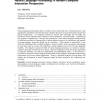Free Online Productivity Tools
i2Speak
i2Symbol
i2OCR
iTex2Img
iWeb2Print
iWeb2Shot
i2Type
iPdf2Split
iPdf2Merge
i2Bopomofo
i2Arabic
i2Style
i2Image
i2PDF
iLatex2Rtf
Sci2ools
AC
1998
Springer
1998
Springer
Natural Language Processing: A Human-Computer Interaction Perspective
Natural language processing has been in existence for more than fifty years. During this time, it has significantly contributed to the field of human-computer interaction in terms of theoretical results and practical applications. As computers continue to become more affordable and accessible, the importance of user interfaces that are effective, robust, unobtrusive, and user-friendly – regardless of user expertise or impediments – becomes more pronounced. Since natural language usually provides for effortless and effective communication in human-human interaction, its significance and potential in human-computer interaction should not be overlooked – either spoken or typewritten, it may effectively complement other available modalities,1 such as windows, icons, and menus, and pointing; in some cases, such as in users with disabilities, natural language may even be the only applicable modality. This chapter examines the field of natural language processing as it relates to human...
AC 1998 | Human-computer Interaction | Natural Language | Natural Language Processing | Software Engineering |
| Added | 21 Dec 2010 |
| Updated | 21 Dec 2010 |
| Type | Journal |
| Year | 1998 |
| Where | AC |
| Authors | Bill Z. Manaris |
Comments (0)

